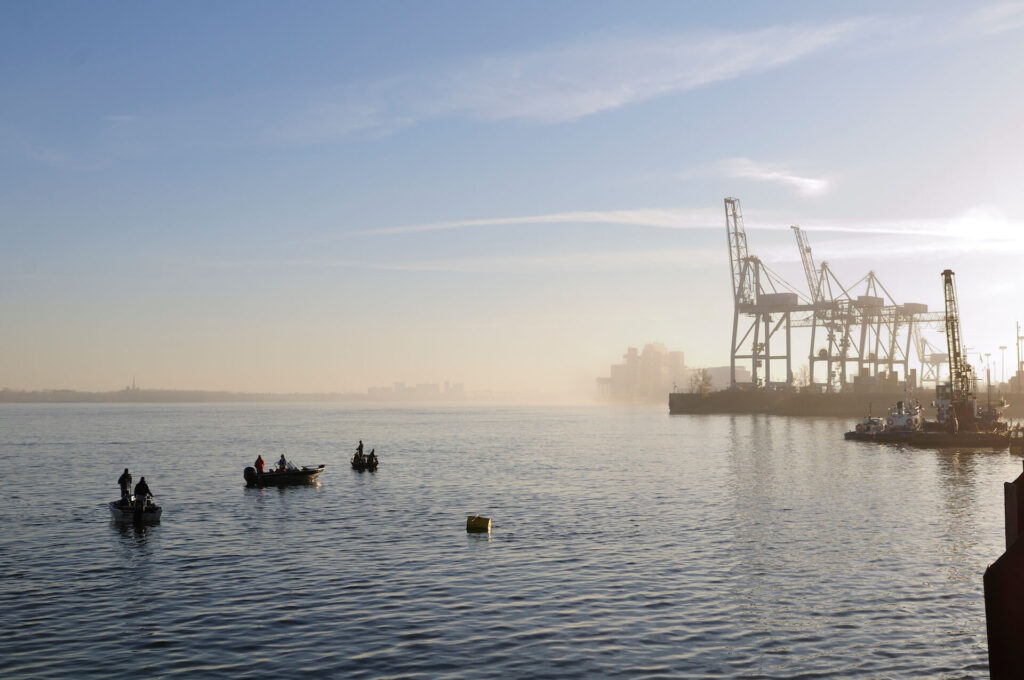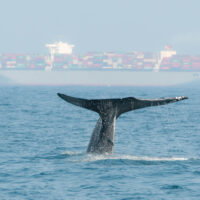Shore power is an effective way of reducing air emissions and improving local air quality.
How Shore Power Works
While docked at port, ships require power to maintain their lights, heating, cooling, and other essential vessel functions. Typically, this power is provided by running the ship’s diesel-fueled auxiliary engines. Shore power, also known as cold-ironing or alternative marine power, is the process of providing electrical power from the shore to a ship while it’s docked, thereby allowing a ships’s auxiliary engines to be turned off and the burning of diesel fuel to cease. Therefore, shore power is an effective way of reducing air emissions and improving local air quality. Additionally, by providing ship operators with an alternative to running diesel auxiliary engines while docked, shore power technology also reduces ship owners’ fuel costs which increases the competitiveness of Canadian ports.
Canada’s Shore Power Technology for Ports Program
The Shore Power Technology Program is one way the Government of Canada is endeavouring to limit air pollution and greenhouse gas emissions in Canada and to improve air quality in ports near major Canadian cities. Ultimately, the program’s aim is to reduce emissions by reducing ship idling at ports. The program started with $27.2 million and is providing up to 50% of the funding required for implementing marine shore power technology to Canadian port authorities, terminal operators and ferry operators to support the deployment of marine shore power technology. Since the program’s launch five projects have been completed across Canada. The complete list of projects which the program is helping to fund, as of August 2017, can be found below:
|
Province |
Port |
Project |
Funding |
|
British Columbia |
Seaspan Ferries Corporation |
Swartz Bay Terminal Shore Power Project |
$88,346.00 |
|
British Columbia |
Vancouver Fraser Port Authority |
Port Metro Vancouver Shore Power Upgrade and Enhancement at Canada Place Cruise Ship Terminal |
$347,477.00 |
|
British Columbia |
British Columbia Ferry Services |
BC Shore Power Project |
$2,022,590.00 |
|
British Columbia |
Vancouver Fraser Port Authority |
Centerm Container Terminal Shore Power Project |
$3,500,000.00 |
|
British Columbia |
Vancouver Fraser Port Authority |
Deltaport Third Berth Container Shore Power Project |
$3,550,000.00 |
|
Nova Scotia |
Halifax Port Authority |
Port of Halifax Shore Power |
$5,000,000.00 |
|
Quebec |
Montreal Port Authority |
Port of Montreal’s Alexandra Pier Shore Power Project |
$5,000,000.00 |
“The Government of Canada is committed to maintaining a safe, efficient and green transportation system. By taking action to reduce greenhouse gases and air pollution, we are improving the lives of Canadians while investing in the future of cleaner transportation. New and emerging technologies are laying the groundwork for Canada’s present and future economic growth.”
The Honourable Marc Garneau
Minister of Transport
Shore Power In Canada Spotlight: Montreal
The Port of Montreal’s Alexandra Pier Shore Power Project has just recently been completed. The project was a cooperative initiative between the Government of Canada, The Government of Quebec and the Montreal Port Authority costing $11 million. The project will reduce greenhouse gas emissions by enabling ships to shut down their diesel engines, and connect to an electrical grid supplied by renewable energy sources. This is expected to reduce approximately 2,800 tonnes of greenhouse gas emissions per year, roughly the equivalent of removing 700 trucks from the road.
Shore Power In Canada Spotlight: Halifax
The Port of Halifax was the first port in Atlantic Canada to implement shore power. The project was part of a $10 million cooperative initiative between the Government of Canada, the Province of Nova Scotia and the Halifax Port Authority that was completed in 2013. Upon completion, the installation was expected to decrease idling by 7%, an amount representative of approximately 123,000 litres of fuel and 370,000 kg of greenhouse gases and air pollutant emissions, contributing to improved air quality.
Shore Power In Canada Spotlight: Vancouver
In 2009, the Vancouver Fraser Port Authority became the first in Canada and third in the world to offer shore power for ships. Canada Place currently has three shore power connection points which has resulted in a reduction of 2,656 tonnes of carbon dioxide. Two additional shore power projects are currently under way at the Centerm Container Terminal in Vancouver and Deltaport in Delta, B.C.
Learn more about shore power in Canada:
Shore Power Technology for Ports Program
Shore Power at the Port of Montreal
Shore Power at the Port of Halifax
Shore Power at the Port of Vancouver
#clearfacts #sustainableshipping



